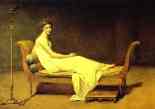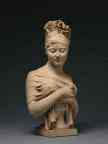Olga's Gallery
Dear Friends of Art,
For the last fortnight we added the collections of four French artists to our on-line exposition: François-Pascal-Simon Gérard, Anne-Louis Girodet de Roussy-Trioson, Antoine-Jean Gros, and Henri Francois Riesener. All of them are pupils of Jacques-Louis David, all of them had a success, they all had as their customers the famous and influential people of their time. To such people belonged Mme Juliette Récamier, whose loveliness was preserved for us by many artists of the late 18th- early 19th century.
Juliette Récamier
 Juliette
Récamier (1777-1849), nèe Jeanne François Julie Adélaïde
Bernard, was born in Lyon on December 4, 1777. Her father was a lawyer
and her mother was just a beauty. In 1793, at the age of 16 Juliette married
a 43-year-old banker, a business acquaintance of her father.
Juliette
Récamier (1777-1849), nèe Jeanne François Julie Adélaïde
Bernard, was born in Lyon on December 4, 1777. Her father was a lawyer
and her mother was just a beauty. In 1793, at the age of 16 Juliette married
a 43-year-old banker, a business acquaintance of her father.
She became one of the foremost society beauties of the day. Her salon attracted all gallant men of the capital, although no one could boast to be her lover. Among her admirers were Jean Baptiste Jules Bernadotte and Lucien Bonaparte, whom she was able to keep remote without discouraging. Napoleon, though, was so much irritated with her rejection to become lady-in-waiting at his court and his intimate friend that he remained hostile towards her all his life. Thus, when in 1806, the bank of M. Récamier got into a difficult situation and Napoleon could have saved it from bankruptcy, he refused, and moreover, in 1811 found a pretext to send Juliette out of Paris. When Napoleon was informed that three of his ministers visited Mme Récamier's, he said sarcastically that he did not ‘suspect that the council of ministers now meets in the house of Mme Récamier”.
Though unhappy in her family life, she remained faithful to her old husband, at least there are no any evidence of her adultery. The first man who aroused any strong feelings in her, according to her own confession, was Prince August of Prussia, who made her a proposal to marry him. She wrote to her husband asking for a divorce; M. Récamier answered with a humble letter asking her to have mercy on his old age and poverty. After some hesitation Juliette refused Prince August. In 1819, she met François René Chateaubriand (1768-1848), French writer and statesman. Their love affair would last to the end of their lives. First Chateaubriand used the affair to achieve his own career goals, but then it turned into sincere and strong affection.
Charles Augustin Sainte-Beuve (1804-1869), French writer and critic, one of the habitués of her house, wrote that people often asked whether Mme Récamier was clever, and answered that ‘she had a mind which did not shine by itself, but a mind, which made the other minds shine. She had a talent of listening and a talent to command the love of everyone who knew her.’
 Many
artists of the time left us depictions of Juliette Récamier. The
very first one is by J.-L. David. David had the fame of a revolutionary,
a celebrated painter, and a friend of great people: Marat, Robespierre
and Napoleon, all that attracted young Mme Récamier. David chose
to paint her in an à la Ancient Greek atmosphere – subdued light,
very few objects (actually an empty room with only a lamp and a divan,
now this kind of divan is called after the model ‘recamier’), the model
wears a tunic and a hairdo of curls. Unfortunately, Juliette's sitting
for the portrait proved problematic – she was whimsical, spoilt and constantly
late, the long hours in an uncomfortable pose irritated and tired her;
the artist in his turn was annoyed with her and with the lightning of the
room, where she sat for him. Although the portrait reached an advanced
stage, it was never finished.
Many
artists of the time left us depictions of Juliette Récamier. The
very first one is by J.-L. David. David had the fame of a revolutionary,
a celebrated painter, and a friend of great people: Marat, Robespierre
and Napoleon, all that attracted young Mme Récamier. David chose
to paint her in an à la Ancient Greek atmosphere – subdued light,
very few objects (actually an empty room with only a lamp and a divan,
now this kind of divan is called after the model ‘recamier’), the model
wears a tunic and a hairdo of curls. Unfortunately, Juliette's sitting
for the portrait proved problematic – she was whimsical, spoilt and constantly
late, the long hours in an uncomfortable pose irritated and tired her;
the artist in his turn was annoyed with her and with the lightning of the
room, where she sat for him. Although the portrait reached an advanced
stage, it was never finished.
“David's picture of her as a distant yet fragile and vulnerable
young woman did not match Mme Récamier's image of herself as a confident
and sophisticated society figure… David finally informed her: ‘Madame,
ladies have their caprices; so do painters. Allow me to satisfy mine; I
shall keep your portrait in its present state.’ Though attempts were made
to bring about a reconciliation, it never occurred.” (cited from David.
by Simon Lee. Phaidon. 1999.)
Joseph Chinard's bust of Mme Récamier, fulfilled in 1801-02, is considered one of the most successful at capturing her spirit and beauty; it was produced in several different versions in both clay and marble.
 In
1805, François Gérard, pupil of J.-L. David and the most
popular portraitist of the day, received commissions for a new portrait
of Mme Récamier. Gérard chose for her antique, but more natural
and warm setting. The painter managed to depict the erotic magnetism of
her appearance, to much praise of the model and admiration of the public.
François Gérard remained a devoted friend of Juliette Récamier
and left several studies and portraits of her, but this one is the most
famous. After her break with Prince August of Prussia she presented him
with this portrait; upon the prince's death, the portrait, in accordance
with his will, was returned to Mme Récamier.
In
1805, François Gérard, pupil of J.-L. David and the most
popular portraitist of the day, received commissions for a new portrait
of Mme Récamier. Gérard chose for her antique, but more natural
and warm setting. The painter managed to depict the erotic magnetism of
her appearance, to much praise of the model and admiration of the public.
François Gérard remained a devoted friend of Juliette Récamier
and left several studies and portraits of her, but this one is the most
famous. After her break with Prince August of Prussia she presented him
with this portrait; upon the prince's death, the portrait, in accordance
with his will, was returned to Mme Récamier.
Juliette Récamier died of cholera on May 5, 1849, leaving after her contradicting opinions and gossips. Some historians think she was just a coquette, who remained in history thanks to her numerous love affairs with outstanding men, others think her almost a saint. Whatever she was she remained in history, but unfortunately took the secret of her charm with her forever.
Bibliography:
Madame Récamier. by Tatyana Sedova. ‘Rabotnitsa’ 1978.
Chambers Biographical Dictionary. Chambers Harrap Publishers
Ltd. 1996.
World Biographical Dictionary. by V. Borodulin et al. Moscow
1998.
David. by Simon Lee. Phaidon. 1999.